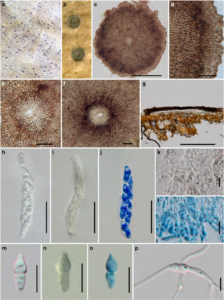Tumidispora shoreae Hongsanan & K.D. Hyde.
Index Fungorum number: IF551376; Facesoffungi number: FoF00945; Fig. 1
Etymology – shoreae referring to the host on which the taxon was collected.
Holotype – MFLU 15-1391
Epiphytic on the upper surface of leaves, appearing as small black dots. Superficial hyphae absent. Sexual morph: Thyriothecia 261 – 283 μm diam. (x̄ = 268 μm, n = 10), superficial, mostly solitary, light brown to brown, circular, flattened, basal peridium poorly developed, easily removed, darker around the central ostiole, dark brown towards the outer lighter rim, irregularly rounded at the margin. Upper wall comprising brown cells of textura angularis, radiating in slightly irregular, but parallel lines from center to the outer rim. Hamathecium comprising 2 μm wide, branched pseudoparaphyses, asci inclined towards the central ostiole. Asci 53 – 55 × 7 – 8 μm (x̄ = 54 × 7 μm, n = 10), 8 – spored, bitunicate, fissitunicate, cylindrical to cylindric – clavate, short pedicellate, apically rounded, with an ocular chamber. Ascospores 14 – 15 × 4 – 5 μm (x̄ = 14 × 5 μm, n = 10), 1 – 2 – seriate, hyaline, narrowly fusiform with subpapillate ends, 1 – septate, constricted at the septum, apical cell swollen and wider and subpapillate, basal cell subconical, smooth-walled. Asexual morph: Undetermined.
Culture characteristics – Ascospores germinating on PDA at 28 °C for 12 h of light/12 h of dark, hyaline to grayish at first, becoming gray. Colonies slow growing, reaching 1.5 cm diam. after 5 days, colony erumpent, velvety, difficult to remove, with dark grey to black mycelium at margin, greyish to grey at the center.
Material examined – THAILAND, Chiang Rai, Doi Mae Salong (Site 1), on dead leaves of Shorea sp. (Dipterocarpaceae), 18 July 2012, N. Tangteerasunan DMSL13 (MFLU 15-1391, holotype); ibid. (KIB, isotype); ex-type living culture, MFLUCC 12-0409, CPC 21385.
Notes – Tumidispora shoreae is most similar to Paramicrothyrium chinensis in having similar thyriothecia and hyaline, 1 – septate ascospores. Tumidispora shoreae has brown to dark brown thyriothecia, with a prominent darkened area around the central ostiole, and 1 – 2 – seriate ascospores which are strongly constricted at the septum, with an apical swollen cell, which is wider than the lower cell and with a subpapillate apex. Paramicrothyrium chinensis has black thyriothecia, and uniseriate ascospores which are not strongly constricted at the septum (Wu et al. 2011).

Fig. 1 Tumidispora shoreae (holotype) a, b Thyriothecia on surface of leaf c Thyriothecium when viewed in squash mount d Upper wall of thyriothecium when viewed in squash mount e, f Central ostiole with darkened cells g Section through thyriothecium h Ascus with 8 ascospores i Ascus in Melzer’s reagent j Ascus in cotton blue reagent k Pseudoparaphyses l Pseudoparaphyses in cotton blue reagent m Ascospore in water n Ascospore in Melzer’s reagent o Ascospore in cotton blue reagent p Germinating ascospore.
